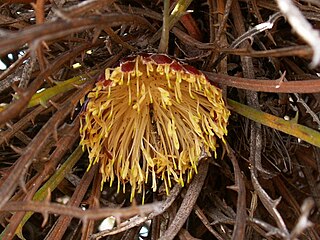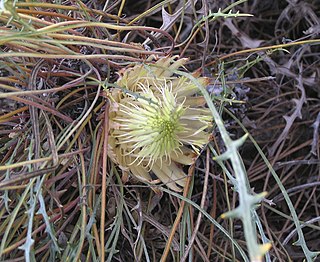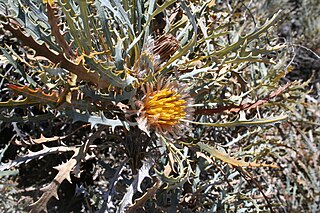
Banksia elegans, commonly known as the elegant banksia, is a species of woody shrub that is endemic to a relatively small area of Western Australia. Reaching 4 m (13 ft) high, it is a suckering shrub that rarely reproduces by seed. The round to oval yellow flower spikes appear in spring and summer. Swiss botanist Carl Meissner described Banksia elegans in 1856. It is most closely related to the three species in the subgenus Isostylis.

Banksia lemanniana, the yellow lantern banksia or Lemann's banksia, is a species of flowering plant in the family Proteaceae, native to Western Australia. It generally grows as an open woody shrub or small tree to 5 m (16 ft) high, with stiff serrated leaves and unusual hanging inflorescences. Flowering occurs over summer, the greenish buds developing into oval flower spikes before turning grey and developing the characteristic large woody follicles. It occurs within and just east of the Fitzgerald River National Park on the southern coast of the state. B. lemanniana is killed by bushfire and regenerates from seed.

Banksia arctotidis is a species of prostrate shrub that is endemic to the southwest of Western Australia. It has leaves that are pinnately divided to the midrib, cream-coloured flowers and hairy, egg-shaped fruit.

Banksia armata, commonly known as prickly dryandra, is a species of often sprawling shrub that is endemic to Western Australia. It has deeply serrated leaves with sharply pointed lobes and spikes of about 45 to 70 yellow flowers.

Banksia comosa, commonly known as Wongan dryandra, is a species of shrub that is endemic to Western Australia. It has linear leaves with widely spaced, sharply pointed serrations, heads of yellow flowers and glabrous fruit.
Banksia cypholoba is a species of dwarf, prostrate shrub that is endemic to Western Australia. It has pinnatipartite leaves with twenty-five to forty triangular lobes on each side, heads of about sixty brownish and yellow flowers and mostly glabrous follicles.

Banksia falcata, commonly known as prickly dryandra, is a species of prickly, column-shaped shrub that is endemic to Western Australia. It has serrated or pinnatipartite leaves, heads of up to 150 yellow flowers and soft-hairy fruit.

Banksia rufa is a species of prostrate shrub that is endemic to the south-west of Western Australia. It has broadly linear, pinnatifid or pinnatipartite leaves with between five and twenty lobes on each side, yellow, orange or brownish flowers in heads of forty or more, and glabrous, egg-shaped follicles.
Banksia lepidorhiza is a species of prostrate shrub that is endemic to Western Australia. It has underground stems, linear pinnatipartite leaves with sharply pointed lobes, pink, cream-coloured and yellow flowers in head of about thirty and egg-shaped follicles. It is only known from near Woodanilling.

Banksia dallanneyi, commonly known as couch honeypot, is a species of prostrate shrub that is endemic to Western Australia. It only has a short above-ground stem, pinnatipartite or pinnatisect leaves, between thirty and seventy variously coloured flowers and glabrous, egg-shaped fruit.

Banksia nana, commonly known as dwarf dryandra, is a species of shrub that is endemic to a small area in the south-west of Western Australia. It has underground stems, pinnatipartite leaves with sharply-pointed lobes, pale green or yellow flowers and broadly egg-shaped follicles.
Banksia porrecta is a species of prostrate shrub that is endemic to the south-west of Western Australia. It has hairy, underground stems, pinnatipartite leaves with up to forty narrow triangular lobes on each side, yellow flowers in heads of between twenty and thirty, and one or two egg-shaped follicles in each head.

Banksia bella, commonly known as the Wongan dryandra, is a species of dense shrub that is endemic to a restricted area of Western Australia. It has narrow, deeply serrated leaves covered with white hairs on the lower surface, heads of yellow flowers and few follicles in the fruiting head.

Banksia sclerophylla is a species of shrub that is endemic to the south-west of Western Australia. It has spreading stems, linear, pinnatipid leaves with triangular lobes on the sides, yellow flowers in heads of between forty and seventy, and elliptical follicles.

Banksia serratuloides is a species of small shrub that is endemic to Western Australia. It has linear, pinnatipartite leaves, yellow and pink flowers in heads of about forty and hairy, wrinkled follicles.

Banksia shuttleworthiana, commonly known as bearded dryandra, is a species of low, spreading shrub that is endemic to Western Australia. It has thin, woolly-hairy stems, linear pinnatisect leaves, creamy brown to purplish flowers in heads of about forty and later, only a few egg-shaped follicles in each head.

Banksia splendida, commonly known as shaggy dryandra, is a species of shrub that is endemic to the southwest of Western Australia. It has sharply-pointed linear leaves that are woolly on the lower surface, cream-coloured and maroon or yellow flowers in heads of between 65 and 115, and later up to eight egg-shaped follicles in each head.

Banksia stenoprion is a species of prostrate shrub that is endemic to the south-west of Western Australia. It has short, underground stems, pinnatisect leaves with triangular lobes, golden, mauve or purple flowers in heads of up to ninety, and egg-shaped follicles.

Banksia tridentata, commonly known as yellow honeypot, is a low-growing shrub that is endemic to the southwest of Western Australia. It has narrow egg-shaped leaves with a sharp point on the tip, greenish yellow flowers in heads of between 85 and 125, and elliptical to egg-shaped follicles.

Banksia vestita, commonly known as summer dryandra, is a species of shrub that is endemic to the southwest of Western Australia. It has broadly linear, pinnatifid leaves with sharply pointed teeth on both sides, yellow flowers in heads of between thirty and forty, and broadly egg-shaped follicles.
















